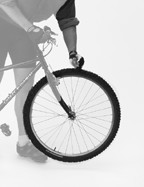
Figure 1:
Test for looseness
• Pick up the bicycle, and sharply hit the top of the tire (Figure 1). The wheel must not come off, be loose, or move from side to side.
• Make sure the quick-release lever cannot be rotated parallel to the wheel (Figure 2).
• When the quick-release is properly tightened, and clamped by the lever in the closed position, the clamping force is adequate to cause metal-into-metal engagement (embossing) of the dropout surfaces.
• See the actual measurements for tightness.
|
|
Figure 1: Test for looseness |
|
|
Figure 2: Test for rotation |
If a wheel attachment does not pass any test, re-adjust the closing force or the quick-release and test again. Do not ride the bicycle until the wheel attachment passes the test. If, after re-adjustment, the quick-release does not pass a test, take your bicycle to your dealer for service.
Warning A quick-release that is not properly adjusted and closed can let the wheel be loose or come off when not expected, which can cause you to lose control and fall. Check the adjustment and close the quick-release before you ride the bicycle.